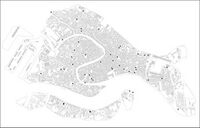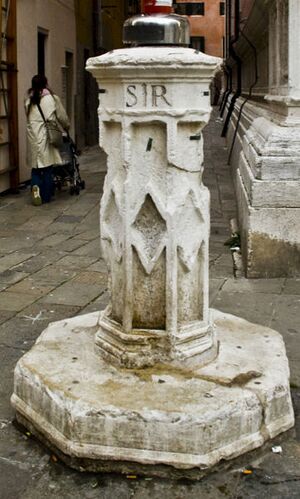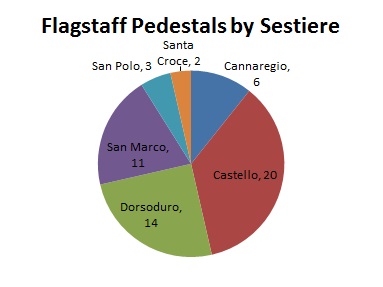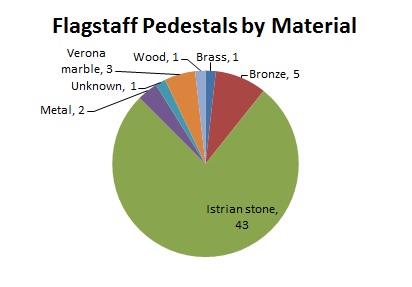Flagstaff Pedestals: Difference between revisions
No edit summary |
|||
| Line 48: | Line 48: | ||
[[Category:Flagstaff Pedestals]] | [[Category:Flagstaff Pedestals]] | ||
[[Category:Functional Art]] | |||
[[Category:Public Art]] | [[Category:Public Art]] | ||
[[Category:Material Culture]] | [[Category:Material Culture]] | ||
Revision as of 10:44, 9 December 2012
 | |
| Total Number | 56 |
|---|---|
| Total Number Missing | 0 |
| Total Number in Use | 10 |

Venetian flagstaff pedestals were pieces of material culture used to display flags symbolizing ownership or allegiance to an organization. These flags, along with their flagstaffs and pedestals, were typically located in campi near the group that they represented. Since far fewer flags are flown today in Venice, the flagstaff pedestal is often the only remaining symbol of this tradition. The pedestals themselves contain decorative designs, as well as historical or religious inscriptions and icons. The pedestal consists of two structural elements, the base and the body. The body holds the wood or metal flagstaff above the ground and contains the artistic elements, while the base is the platform on which the pedestal body rests.
Statistics
- Of the pedestals located in Venice, only 35 contain flagstaffs.
- 34 of the 55 pedestals in Venice are located near the waterfront, which can be attributed to the mercantile and military purposes of the flags they would have flown.
- 2 pedestals, located in San Marco, sit directly in the water.
- 9 pedestals display the Winged Lion of Saint Mark, all of which postdate 1797 AD.
- The oldest flagstaff pedestal is located in San Marco and dates from 1310 AD.
- The most recent flagstaff pedestal is located in Cannaregio and dates from 1985 AD.
Damage and Preservation
For general information pertaining to the sources of damage to Venetian flagstaff pedestals, please see the Damage to public art page.
For general information pertaining to the restoration and preservation of Venetian flagstaff pedestals, please see the Restoration and preservation of public art page.
Specific information regarding the damage and restoration needs of each flagstaff pedestal can be found on the pages dedicated to each individual pedestal, as listed in the map below and in the navigation box under the "See Also" section of this page.
Locations
See Also
| ||||||||
References
NULL
Bibliography
- Rizzi, Alberto. "Scultura Esterna a Venezia." Stamperia di Venezia Editrice, 1987.
- 2010 WPI PreserVenice Project Team
- 2008 WPI PreserVenice Project Team
- 2007 WPI PreserVenice Project Team
- 2000 WPI PreserVenice Project Team

